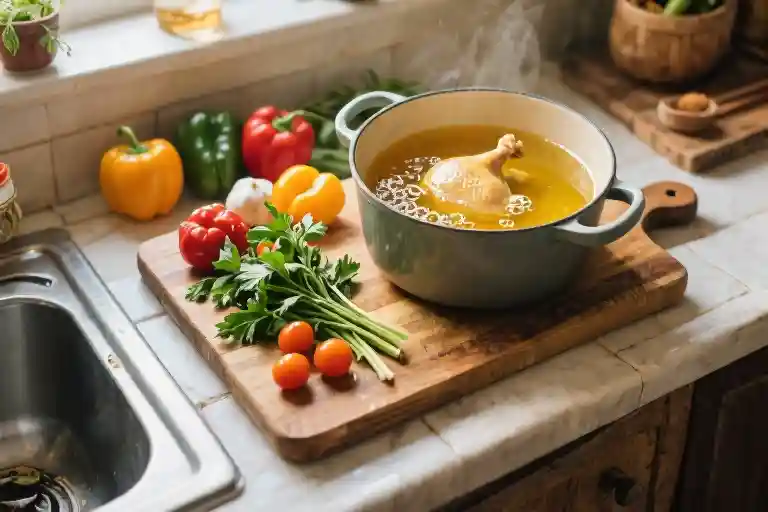The first time I showed up at a client’s doorstep with a baby strapped to my chest and a pot of coq au vin balanced precariously in my arms, I watched their eyebrows disappear into their hairline. Professional chefs aren’t supposed to arrive with infant spit-up stains on their aprons, but this had become my normal – developing restaurant-quality meals while my toddler clung to my leg, calculating grocery budgets down to the last penny as I nursed during prep time.
Moving back from Los Angeles halved our food budget overnight. Where I once sourced truffle oil and heirloom tomatoes without a second thought, I now stood in the supermarket aisle comparing the unit price of canned beans. The math was brutal: one fancy dinner in our old life could now feed our growing family for three days. But something surprising happened in that constraint – I discovered that great cooking isn’t about lavish ingredients, but about layering flavors with intention. My professional training became a survival tool, transforming humble potatoes and dried herbs into meals that made us feel nourished in every sense.
Those early days built the foundation for what my cooking philosophy has become. I stopped seeing ‘budget meals’ as compromise and started treating them as creative challenges. The same skills that once earned me praise in upscale kitchens now helped me stretch a $5 whole chicken into four distinct meals. When clients asked how I managed to make such flavorful food while clearly being exhausted (and occasionally wearing pureed carrots in my hair), I realized my two identities – chef and mother – weren’t in conflict but were actually informing each other in ways I couldn’t have predicted.
What emerged wasn’t just a collection of cheap recipes, but an entire approach to cooking that honors both professional standards and real-world parenting chaos. The baby who once slept in a carrier while I chopped onions is now old enough to measure ingredients, and the clients who initially raised eyebrows at my unconventional methods have become regulars who request my ‘magic beans’ recipe. There’s an alchemy that happens when you stop seeing limitations as barriers and start treating them as creative parameters – and that’s what I want to share with every parent staring into their nearly empty fridge wondering how to make something worthy of their family’s love.
From LA to Home Kitchen: My Dual Identity Cooking Experiment
The first time I delivered coq au vin to a client with a six-month-old strapped to my chest, I knew my culinary career had taken an unexpected turn. Los Angeles felt like another lifetime – those years of testing recipes in professional kitchens with unlimited access to exotic ingredients. Our move back to the Midwest came with a harsh reality: our $800 monthly food budget shrank to $200 overnight. Suddenly, I wasn’t just cooking for discerning restaurant critics, but for two toddlers who judged my meals by how many smiley faces I could create with ketchup.
The Birth of a Budget Cooking Revolution
That’s when the website began – not as some grand entrepreneurial vision, but as my desperate attempt to remember which $3 hacks actually worked. I’d scribble notes while nursing: Substitute smoked paprika for expensive chorizo in the chili… Use pickle juice to tenderize cheap cuts… What started as my personal recipe journal became something unexpected. Other parents began writing in, not just for the budget family meals, but for the messy reality behind them – the burnt casseroles, the failed attempts at organic baby food that ended up as wallpaper paste.
A Week in the Life of a Baby-Wearing Chef
Tuesday: 6 AM – Prep butternut squash soup between diaper changes. The slow cooker becomes my sous chef, simmering while I take the kids to storytime. Noon – Puree soup one-handed while restraining a toddler attempting to climb the fridge. 3 PM – Deliver to Mrs. Henderson, who still doesn’t know the white stain on my apron is breastmilk, not béchamel. Thursday: Discover that ground turkey (half the price of beef) makes excellent meatballs when soaked in milk. Friday: My three-year-old “helps” by rearranging all my spice jars – accidentally inventing a new curry blend in the process.
What emerged from this chaos were three undeniable truths about cooking on a tight budget: First, flavor is about clever substitutions, not expensive ingredients (that $8 truffle oil is just garlic-infused olive oil wearing a tuxedo). Second, time management matters more than knife skills when you’re working around nap schedules. And third – perhaps most importantly – the meals that nourish us most aren’t measured by Michelin stars, but by the tiny hands that keep sneaking bites of raw cookie dough when you’re not looking.
This wasn’t the cooking career I’d envisioned during culinary school, but it became something more vital. Those stained recipe cards and sleep-deprived kitchen experiments taught me that great cooking isn’t about perfection – it’s about showing up, day after day, with whatever ingredients life hands you. Even if that means making pesto with walnuts instead of pine nuts because someone just outgrew their shoes… again.
The 3 Truths About Delicious Food on a Budget
Cooking well with limited resources isn’t about deprivation—it’s about working smarter with what you have. Over years of stretching grocery budgets while raising two kids, I’ve discovered these fundamental principles that transformed how I approach every meal.
Flavor Alchemy: The Spice Rack Revolution
When our food budget got cut by 75% after moving from LA, I panicked about losing the complex flavors I loved. Then I realized: most ‘gourmet’ tastes come from technique, not expensive ingredients. My Mexican Spice Chicken Legs became the breakthrough recipe—using $0.99 chicken thighs and a spice blend that mimics mole sauce:
- 2 tsp cocoa powder (instead of expensive chocolate)
- 1 tbsp peanut butter (replaces nuts)
- Smoked paprika (stands in for chipotle peppers)
The trick? Identify the dominant flavor profile you’re craving (earthy, smoky, bright), then find affordable pantry staples that hit those same notes. I once made ‘truffle’ mashed potatoes using sautéed mushrooms and a splash of soy sauce—my clients never guessed the substitution.
The Circular Meal System
Sunday afternoons became sacred when I developed this rotating prep method that turns one big cook session into 5 varied meals. Here’s how $30 worth of groceries feeds our family of four for a week:
- Roast 2 whole chickens → Day 1: Herb-roasted chicken with veggies → Save bones/carcass
- Simmer bones for stock → Day 2: Chicken noodle soup → Reserve 2 cups shredded meat
- Mix meat with mayo/curry powder → Day 3: Chicken salad sandwiches → Save vegetable scraps
- Blend scraps into stock → Day 4: Creamy vegetable soup → Freeze remaining broth
- Use broth for risotto → Day 5: Mushroom risotto (add $1.50 mushrooms)
The system works because each meal builds on the last while disguising repetitions. My kids think they’re getting completely new dishes—I just know I’m saving 3 hours of active cooking time weekly.
The Leftover Metamorphosis Formula
Professional kitchens waste nothing, and neither should home cooks. My rule: any leftover must transform into something unrecognizable within 48 hours. The magic happens through these three techniques:
- Texture Shift: Roast beef → shred for tacos → grind for Bolognese
- Temperature Flip: Steamed rice → chilled rice pudding → fried rice cakes
- Culture Swap: Italian pasta → Asian noodle stir-fry → Mexican pasta salad
Last week’s $8 pork shoulder became: Monday’s carnitas → Wednesday’s dumpling filling → Friday’s fried rice mix-in. The key is having a few ‘neutral base’ ingredients (eggs, rice, tortillas) that can absorb any leftover without tasting repetitive.
What surprised me most wasn’t the money saved (though we cut our grocery bill by 40%), but how creative constraints made me a better cook. When you can’t rely on expensive ingredients, you start truly understanding how flavors build and transform. Now when I see ‘budget meals’ that just mean bland austerity, I want to show people this truth: limitation breeds invention, and some of my most memorable meals came from my most financially stretched seasons.
The 5 Kitchen Tools That Saved My Sanity as a Cooking Mom
There’s a particular kind of chaos that happens when you’re reducing a pan sauce while a toddler clings to your leg like a koala. Over the years, my kitchen has become less of a culinary laboratory and more of a survival bunker – one where every tool earns its real estate by answering three questions: Can I use it with one hand? Will it prevent a 911 call? And does it cost less than a week’s worth of daycare?
1. The Slow Cooker That Doubles as a Babysitter
My $29 slow cooker isn’t just an appliance; it’s a co-parent. While most parenting blogs warn against leaving children unattended, nobody mentions you can’t leave a simmering pot unsupervised either. This is where the slow cooker shines – its locked lid means no curious little fingers get burned, and the automatic switch to ‘warm’ mode means dinner won’t char because someone needed a diaper change.
Pro tip: Brown meats in the morning during that magical 20-minute window when both kids are occupied (one with breakfast, the other with trying to fit a whole banana in their nose). Transfer to the slow cooker with hardy vegetables like carrots and potatoes. By dinner time, you’ve got a meal that tastes like you’ve been slaving over it, not just surviving through it.
2. The Cutting Board That Stays Put (Unlike My Toddler)
A $15 silicone-bottomed cutting board might not sound revolutionary until you’ve tried dicing onions while breastfeeding. Traditional boards slide around like toddlers on a hardwood floor after juice spills. This one stays planted through one-handed chopping, impromptu toddler ‘help’, and those moments when you need to quickly move everything aside to wipe a nose/butt/crisis.
Bonus feature: The slight lip catches juices, preventing the dreaded raw chicken runoff that turns kitchen floors into biological hazards – especially important when tiny bare feet are involved.
3. The Microwave Box That Outperforms My College Degree
This three-tiered microwave steamer ($22 on Amazon) is the Swiss Army knife of desperate parenting meals. Layer rice on the bottom, frozen veggies in the middle, and pre-marinated protein on top. Five minutes later – and I’ve timed this between tantrums – you’ve got a balanced meal. The compartments keep flavors separate for picky eaters, and the entire stack nests for storage.
Real-talk moment: Yes, I went to culinary school. No, I don’t feel guilty about microwaving dinner. Some nights, the victory isn’t in the technique but in getting food into small bodies before bedtime.
4. The $40 Chef’s Knife That Doesn’t Judge Me
When we downsized our budget, the $200 Japanese gyuto knife was the first luxury to go. Its replacement? A Victorinox Fibrox that performs 90% as well for 20% of the price. The fiberglass handle stays grippy when covered in pureed sweet potatoes, and the blade takes an edge well enough to break down a chicken one-handed (a skill I developed while wearing a baby carrier).
Safety note: I keep it in a wall-mounted magnetic strip – out of reach but always accessible when nap time coincides with meal prep.
5. The Collapsible Dish Rack That Gets My Small Kitchen
In our post-LA apartment, the kitchen is so small that if I drop a spoon, it lands in the living room. This foldable dish rack ($18) lives on the counter during the three daily dish avalanches, then collapses flat against the backsplash when we need the space for homework/art projects/mom’s nervous breakdown. The bamboo slats dry pots faster than towel-drying, saving about 47 minutes a week – which, in parent time, equals roughly 3.5 episodes of Bluey.
Confession: Sometimes I leave it up just to feel like a real adult with a designated dish-drying area. The illusion of control is everything.
These tools aren’t just about cooking; they’re about creating a kitchen that accommodates both your culinary standards and your reality. Because the truth is, parenting while cooking isn’t about perfection – it’s about finding ways to keep the people you love fed without losing yourself in the process. And if some nights that means serving microwaved vegetables with takeout-level pride? That’s not cutting corners. That’s claiming your victory where you find it.
The Language of Feeding: Stories from My Kitchen
A woman in Dublin once emailed me a photo of shepherd’s pie she’d made using my ‘five-ingredient miracle’ recipe. Her message read: ‘First meal I cooked after my mastectomy. Tasted like being alive again.’ That screenshot lives in my favorites folder, right next to the video of a Tokyo dad showing his toddler how to fold dumplings using my ‘no-stick’ technique. These aren’t just cooking successes—they’re proof that feeding someone operates on a frequency beyond nutrition.
When Recipes Become Love Letters
My website’s comment section accidentally became a confessional booth. There’s the college student who used my ‘ramen upgrade’ guide to impress her immigrant parents during their first campus visit (‘Dad said it tasted like home but cheaper’). The widower from Saskatchewan who methodically worked through all my soup recipes during his first winter alone (‘The kitchen timer gave me something to listen for’). My personal favorite: the lesbian couple who bonded with their conservative parents over my ‘political neutral’ Thanksgiving menu (‘Turns out, everyone agrees about crispy roast potatoes’).
What fascinates me isn’t that they used my recipes, but what they were really making: edible bridges between people. That Dublin woman wasn’t just recovering physically—she was relearning how to nurture herself. Those dumplings in Tokyo? They’re that father’s way of saying ‘I see you’ to a child too young for complex conversation.
The Archaeology of Family Meals
My daughter’s seventh birthday request—’Make that chicken with the crispy skin like when I had chickenpox’—reveals something profound. Flavors bookmark our memories with shocking precision. The cinnamon rolls I burned during my son’s toddler tantrum phase? He now requests them charred on purpose (‘That’s how I know they’re yours’).
This is why I photograph failed dishes alongside triumphs. The lopsided birthday cake held together by toothpicks, the ‘experimental’ curry that stained our tupperware permanently yellow—these are the artifacts that will outlast me. Not as culinary achievements, but as evidence that someone kept trying to say ‘I love you’ in a language that requires chewing.
The Economics of Nourishment
Here’s the dirty secret those fancy food magazines won’t tell you: The most memorable meals often cost the least. My family’s ‘poverty paella’—made with dollar-store saffron and frozen shrimp—still gets requested over restaurant versions. Why? Because the story (‘Remember when Mom pretended this was our Spanish vacation?’) became part of the seasoning.
That Tokyo dad’s dumplings probably cost less than the subway ride to buy takeout. The Dublin woman’s shepherd’s pie ingredients totaled maybe €8. Yet the emotional yield? Priceless. This is the real ‘budget cooking’ hack: understanding that scarcity often breeds creativity, and creativity becomes nostalgia.
Your Turn at the Table
I’ll leave you with this challenge: Next time you cook, pretend you’re writing a edible postcard to your future self. What memory do you want the smell of browning butter to trigger five years from now? How can you turn tonight’s ‘quick dinner for busy families’ into tomorrow’s ‘remember when…’? Because long after the meal ends, what remains isn’t the taste—it’s the story about who you were feeding, and why it mattered.
The Last Bite: Where Love Meets Practicality
The timer just went off on my phone—it’s not for the oven, but for the free recipe bundle download counter. In twenty minutes, the link will expire, just like that batch of cookies your toddler “helped” make last week. I know how this goes: you bookmark things with every intention to return, but life happens. The baby spits up on your only clean blouse. The school calls about forgotten permission slips. The dog eats the grocery list.
Which is exactly why I created these emergency dinner plans in the first place. Not as another item on your endless to-do list, but as a life raft for those nights when ordering takeout feels like the only option (until you remember the delivery fee could buy three sweet potatoes and a whole chicken). The PDF isn’t fancy—no food stylist photos here—just the same scribbled notes I use when my brain’s too fried to remember whether cumin goes with carrots (it does, spectacularly).
Somewhere between pureeing baby food and prepping client meals, I realized we’ve been sold a lie about “good enough” cooking. That it requires matching tableware or obscure ingredients or uninterrupted hours. The truth? Your family won’t remember the Instagram-worthy plating. They’ll remember how you turned Tuesday’s leftover rice into Wednesday’s fried rice balls, how you let them sprinkle cheese over everything, how the kitchen smelled when you finally sat down together—even if it was 8:47pm and someone was already in pajamas.
So take the recipes. Or don’t. The real secret ingredient was never in the instructions anyway—it’s in the stubborn belief that feeding people matters, even when you’re exhausted, even when the budget’s tight, even when you burn the garlic bread. Because every scrambled egg served with a side of “Mommy’s tired” still says “I love you” in the oldest language humans know.
“Good food isn’t about perfection—it’s about showing up, one imperfect meal at a time.”
[→ Grab your Emergency Dinner Pack here] (link expires in 19 minutes)
P.S. If you miss the deadline? The roasted vegetable formula on page 3 works like this: any veg + olive oil + salt + 400°F oven + however long naptime lasts = dinner. You’ve always known more than you think.





